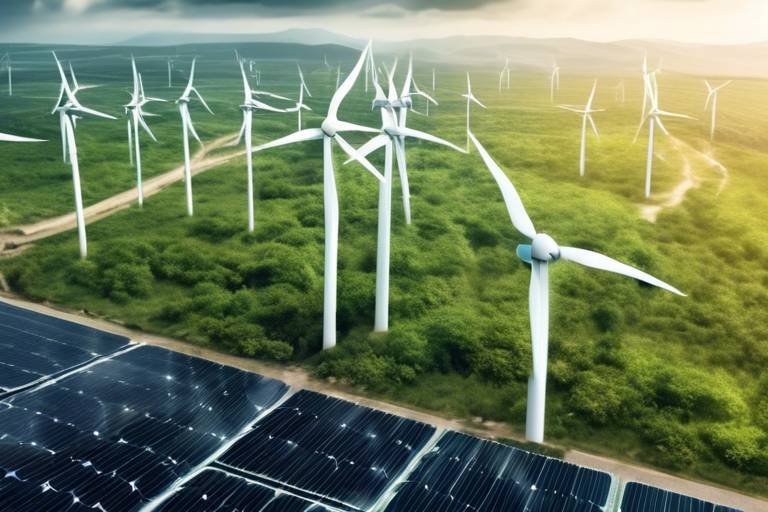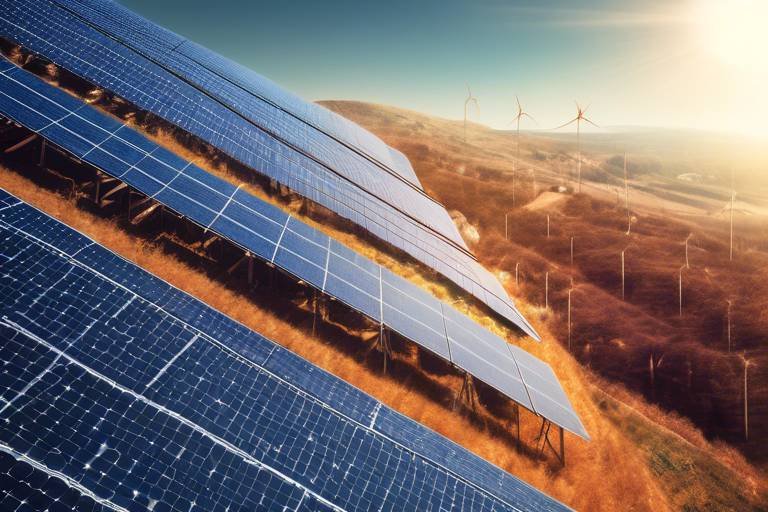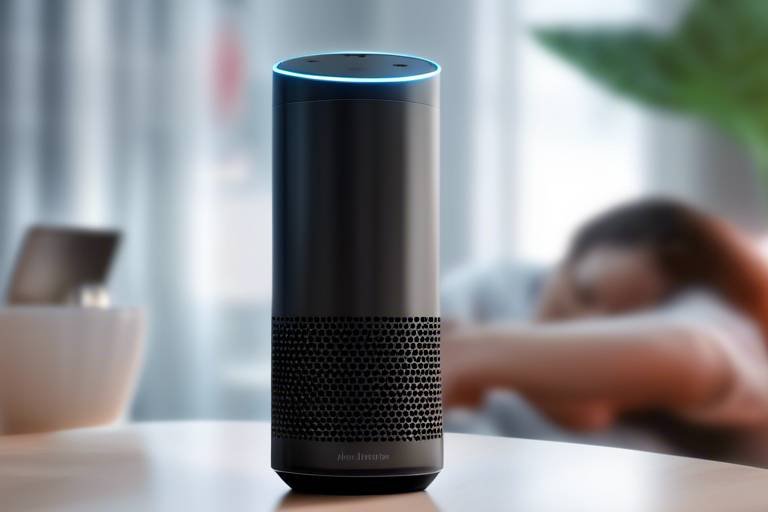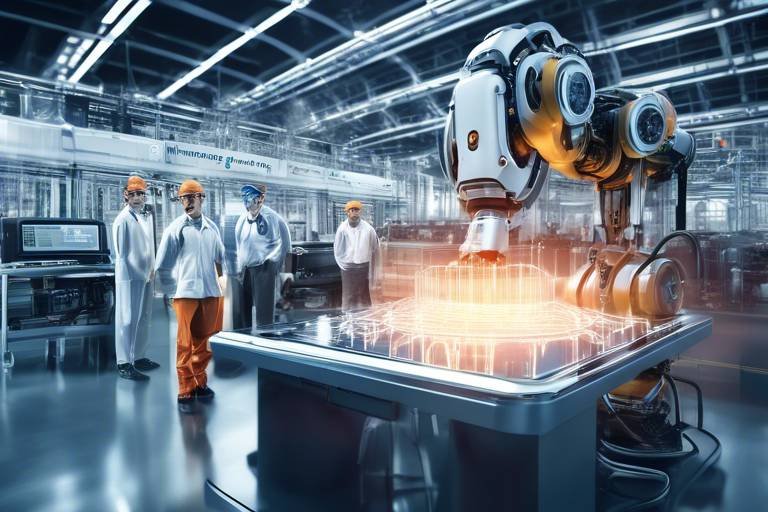How AI can Drive the Future of Renewable Energy
In today's rapidly evolving world, the intersection of technology and sustainability is more crucial than ever. Artificial Intelligence (AI) stands at the forefront of this transformation, promising to revolutionize the renewable energy sector. Imagine a future where energy sources are not only abundant but also efficiently managed, maximizing output while minimizing waste. This isn't just a dream; it's becoming a reality through the innovative applications of AI. From optimizing energy consumption to enhancing storage solutions, AI is paving the way for a cleaner, greener future.
As we delve deeper into this exciting topic, we'll explore how AI is reshaping energy management, predictive maintenance, and even policy-making in the renewable sector. Each advancement brings us one step closer to a sustainable energy landscape, where renewable sources dominate and fossil fuels become a thing of the past. So, how exactly does AI fit into this picture? Let's break it down.
At the heart of energy efficiency lies AI-driven energy management systems. These systems are designed to analyze consumption patterns, predict future energy demands, and automate energy distribution. By harnessing vast amounts of data, AI can identify trends that would be nearly impossible for humans to discern. For instance, imagine a smart home that learns your daily habits and adjusts energy usage accordingly, reducing costs while ensuring comfort. This level of optimization not only leads to significant cost savings but also enhances overall system efficiency.
Furthermore, AI can facilitate the integration of various energy sources, ensuring that renewable energy is utilized effectively. By predicting peak usage times and adjusting supply accordingly, AI helps in balancing the load across the grid. This means fewer outages and a more reliable energy supply for everyone. The implications are profound: a future where energy is not just consumed but managed intelligently, leading to an overall reduction in carbon footprints.
One of the most exciting applications of AI in renewable energy is its role in predictive maintenance. Imagine a wind turbine that can notify operators of potential failures before they happen. By analyzing historical performance data and environmental conditions, AI can forecast when a turbine is likely to malfunction, allowing for timely repairs. This proactive approach minimizes downtime and reduces maintenance costs, ensuring that renewable assets operate at peak efficiency.
Through data analytics, AI assesses the performance of renewable energy systems, identifying inefficiencies and suggesting improvements. It’s like having a personal trainer for energy systems, constantly pushing for better performance. By tapping into vast datasets, AI can pinpoint exactly where energy production is lagging and recommend actionable steps to enhance output.
Machine learning algorithms play a critical role in this process. They continuously learn from incoming data, adapting and refining their analyses to improve decision-making. This means that as more data is collected, the algorithms become smarter, leading to even greater efficiency gains over time. It’s a self-improving cycle that benefits both energy producers and consumers.
AI-powered real-time monitoring systems are another game-changer. These systems track energy production and consumption continuously, providing insights that help operators optimize performance. For example, if a solar farm is underperforming, real-time data can alert operators to potential issues, allowing for quick intervention. This level of responsiveness is crucial in a world where energy demands are constantly fluctuating.
AI also plays a pivotal role in integrating renewable energy sources into smart grids. Smart grids are the future of energy distribution, allowing for real-time data exchange between energy producers and consumers. With AI facilitating this integration, we can achieve improved load balancing and enhanced grid stability. This not only supports a more resilient energy infrastructure but also empowers consumers to make informed energy choices.
Energy storage is another critical area where AI makes a significant impact. As we rely more on renewable sources like solar and wind, effective storage solutions become essential. AI optimizes battery performance, ensuring that energy is stored and released at the right times. Imagine a world where your electric vehicle charges itself during off-peak hours and discharges energy back to the grid during peak demand. This is the kind of future AI envisions for energy storage.
AI-enhanced battery management systems are crucial for optimizing charging and discharging cycles. By analyzing usage patterns and predicting energy supply fluctuations, these systems extend battery life and improve the efficiency of energy storage solutions. This is vital for balancing supply and demand, ensuring that renewable energy is available when needed.
Advanced AI algorithms can forecast energy supply and demand with remarkable accuracy. This capability enables better planning and utilization of renewable resources, ultimately reducing reliance on fossil fuels. By predicting when energy will be in high demand, AI helps ensure that renewable sources are prioritized, leading to a more sustainable energy future.
Finally, AI can inform and shape renewable energy policies by providing data-driven insights. Policymakers can leverage AI to identify trends and support decision-making processes that promote sustainable energy development and investment. By analyzing vast datasets, AI can highlight areas where investments would yield the most significant impact, guiding governments and organizations toward effective policies that encourage the growth of renewable energy.
- How does AI improve energy efficiency? AI analyzes usage patterns and optimizes energy distribution, leading to reduced costs and enhanced efficiency.
- What is predictive maintenance? Predictive maintenance uses AI to forecast potential failures in renewable assets, allowing for timely repairs and minimizing downtime.
- How does AI contribute to smart grids? AI facilitates real-time data exchange in smart grids, improving load balancing and enhancing overall grid stability.
- Can AI help in energy storage? Yes, AI optimizes battery performance and manages charging cycles, ensuring efficient energy storage and usage.

AI in Energy Management
Artificial intelligence (AI) is revolutionizing the way we manage energy consumption. Imagine having a personal assistant that not only tracks your energy usage but also predicts when and how much energy you will need in the future. That's exactly what AI does for energy management systems. By analyzing usage patterns and predicting demand, AI can automate energy distribution, leading to significant cost savings and enhanced efficiency.
One of the most exciting aspects of AI in energy management is its ability to optimize energy consumption. For instance, AI algorithms can learn from historical data and identify peak usage times, allowing energy providers to adjust their supply accordingly. This means that during high-demand periods, energy can be distributed more effectively, thus reducing strain on the grid and preventing outages. The result? A more reliable energy supply and a happier, more satisfied consumer base.
Moreover, AI can help businesses and households reduce their energy costs. By providing insights into energy usage, AI enables users to make informed decisions about when to use energy-intensive appliances. For example, if your AI system detects that energy rates are lower during off-peak hours, it can suggest running your dishwasher or washing machine at that time. This not only saves money but also contributes to a more sustainable energy ecosystem.
In addition to optimizing consumption, AI also plays a crucial role in energy distribution. With the rise of renewable energy sources, such as solar and wind, managing the variability of these resources becomes challenging. AI can analyze real-time data from various energy sources, ensuring that energy is distributed efficiently across the grid. This means that when the sun is shining or the wind is blowing, AI can dynamically adjust the flow of energy to where it’s needed most, maximizing the use of renewable resources.
To give you a clearer picture, let's look at a simple table that illustrates how AI enhances energy management:
| Aspect | AI Contribution |
|---|---|
| Energy Consumption | Predicts usage patterns and suggests optimal times for energy use. |
| Cost Savings | Identifies opportunities to reduce energy costs through better planning. |
| Energy Distribution | Ensures efficient distribution of renewable energy across the grid. |
| Grid Stability | Balances load and prevents outages by predicting demand fluctuations. |
As we look to the future, the role of AI in energy management will only grow. The integration of smart technologies and AI-driven systems will empower consumers and businesses alike to take control of their energy usage. In a world where every kilowatt counts, AI will be the key to unlocking a more efficient, sustainable, and cost-effective energy future.
- How does AI predict energy demand? AI uses historical data and machine learning algorithms to analyze consumption patterns and forecast future energy needs.
- Can AI help reduce energy costs? Yes! By optimizing energy usage and suggesting off-peak times for high-demand appliances, AI can significantly lower energy bills.
- What role does AI play in renewable energy distribution? AI monitors real-time data from renewable sources, ensuring that energy is distributed efficiently and effectively across the grid.

Predictive Maintenance for Renewable Assets
In the realm of renewable energy, the term predictive maintenance is gaining traction, and for good reason. Imagine a world where wind turbines spin smoothly and solar panels soak up the sun without interruption. This is not just a dream; it’s becoming a reality thanks to the power of artificial intelligence. By leveraging advanced algorithms and data analytics, AI can forecast potential failures in renewable energy assets, such as wind turbines and solar panels, before they occur. This proactive approach allows operators to schedule timely repairs, minimizing downtime and ultimately saving costs.
Think of predictive maintenance as a crystal ball for energy assets. Instead of waiting for a breakdown to happen, AI analyzes historical data and real-time information to identify patterns and anomalies. For instance, if a wind turbine shows signs of unusual vibrations or a solar panel's output dips unexpectedly, AI can alert technicians to investigate further. This not only prevents costly repairs but also ensures that energy production remains steady, which is crucial for meeting the ever-increasing demand for clean energy.
The benefits of predictive maintenance extend beyond just cost savings. It enhances the reliability of renewable energy systems, ensuring they operate at peak performance. A well-maintained asset can produce energy more efficiently, which is vital in a world striving for sustainability. Moreover, the data collected through predictive maintenance can be used to improve future designs and installations, creating a feedback loop that continuously enhances the renewable energy landscape.
To illustrate the impact of predictive maintenance, consider the following table that outlines the differences between traditional maintenance and AI-driven predictive maintenance:
| Aspect | Traditional Maintenance | Predictive Maintenance |
|---|---|---|
| Approach | Reactive, fixing issues as they arise | Proactive, anticipating failures before they occur |
| Cost | Higher due to emergency repairs | Lower due to planned maintenance |
| Downtime | Unplanned, leading to energy loss | Minimized, ensuring continuous energy production |
| Data Utilization | Limited to historical records | Real-time data analysis for informed decisions |
In conclusion, the integration of AI in predictive maintenance is revolutionizing how we manage renewable energy assets. By shifting from a reactive to a proactive maintenance strategy, we can ensure that our renewable energy systems are not only more efficient but also more reliable. As we continue to harness the power of AI, the future of renewable energy looks brighter than ever.
- What is predictive maintenance? Predictive maintenance uses data analysis tools and techniques to detect anomalies in equipment and address them before they lead to failures.
- How does AI contribute to predictive maintenance? AI analyzes vast amounts of data to identify patterns and predict potential failures, allowing for timely maintenance and repairs.
- What are the benefits of predictive maintenance in renewable energy? It reduces downtime, lowers maintenance costs, and enhances the reliability and efficiency of renewable energy systems.
- Can predictive maintenance be applied to all renewable energy assets? Yes, it can be applied to various assets, including wind turbines, solar panels, and energy storage systems.

Data Analytics for Performance Optimization
When it comes to maximizing the efficiency of renewable energy systems, data analytics plays a pivotal role. Imagine you’re a conductor of an orchestra, where each musician represents a different energy source—solar panels, wind turbines, and hydroelectric plants. To create a harmonious symphony, you need to understand how each instrument performs individually and how they work together. That’s where data analytics steps in, providing the insights needed to fine-tune performance and ensure that every energy source is contributing optimally.
Data analytics collects and analyzes vast amounts of information from various renewable energy sources. This data can include everything from weather patterns and energy production rates to equipment performance metrics. By harnessing this information, operators can identify inefficiencies, predict energy output, and make informed decisions that enhance overall system performance. Just like a skilled chef who adjusts ingredients based on taste tests, energy managers can tweak their operations based on real-time data.
One of the most exciting aspects of data analytics is its ability to uncover trends and patterns that might not be immediately visible. For instance, by analyzing historical performance data, AI can spot seasonal variations in energy production. This knowledge allows operators to prepare for fluctuations in energy supply, ensuring that they can meet demand without relying heavily on fossil fuels. In essence, data analytics acts as a crystal ball, giving energy producers a glimpse into the future.
Moreover, the integration of machine learning algorithms into data analytics further amplifies its effectiveness. These algorithms can process enormous datasets much faster than any human could, learning from past data to make predictions about future performance. For example, they can analyze how different weather conditions affect solar panel efficiency, allowing for proactive adjustments to maximize energy capture. This level of optimization is crucial for ensuring that renewable energy systems operate at peak performance.
To illustrate the impact of data analytics, consider the following table that summarizes key benefits:
| Benefit | Description |
|---|---|
| Increased Efficiency | Identifies inefficiencies in energy production and consumption. |
| Predictive Insights | Forecasts future energy output based on historical data. |
| Enhanced Decision-Making | Supports operators in making informed operational adjustments. |
| Cost Savings | Reduces unnecessary expenditures by optimizing resource use. |
In conclusion, data analytics is not just a tool; it’s a game changer in the realm of renewable energy. By leveraging the power of data, energy producers can transform their operations, leading to more efficient and sustainable energy systems. As we continue to embrace technology, the future of renewable energy looks brighter than ever, with data analytics at the forefront of this exciting evolution.
- What is data analytics in renewable energy? Data analytics involves collecting and analyzing data from renewable energy systems to optimize performance and enhance decision-making.
- How does AI contribute to data analytics? AI employs machine learning algorithms to process large datasets quickly, uncovering insights that can lead to improved energy production and efficiency.
- Why is performance optimization important for renewable energy? Optimizing performance ensures that renewable energy systems operate at their best, maximizing output and reducing reliance on non-renewable sources.

Machine Learning Algorithms
When we think of the future of renewable energy, one of the most exciting components is the role of . These algorithms are like the brains behind the operation, analyzing massive amounts of data from various renewable sources. Imagine trying to find a needle in a haystack, but instead of a needle, you're looking for inefficiencies in energy production. That’s where machine learning shines! It can sift through data faster than any human ever could, identifying patterns and anomalies that would otherwise go unnoticed.
Machine learning algorithms can predict energy output based on historical data, weather conditions, and even seasonal variations. For instance, by analyzing past performance data of solar panels, these algorithms can forecast how much energy a solar farm will produce on a cloudy day versus a sunny one. This kind of predictive capability is invaluable for energy operators who need to manage supply effectively. By anticipating energy production, they can make informed decisions about how to distribute resources, ensuring that energy is available when and where it’s needed most.
Moreover, the algorithms can also learn from their mistakes. This means that if a particular model predicts an energy output that doesn't match reality, it can adjust its calculations for future predictions. This adaptive learning process is akin to how we humans learn from experience. Over time, the algorithms become more accurate, leading to improved energy management and reduced waste.
In addition to optimizing energy production, machine learning can also enhance resource management. For example, it can analyze data from wind turbines to determine the optimal angle for blades based on current wind conditions. This not only maximizes energy output but also extends the lifespan of the equipment by reducing unnecessary wear and tear. The integration of these algorithms into renewable energy systems creates a virtuous cycle—more efficiency leads to more energy, which leads to further investment in renewable technologies.
To give you a clearer picture, let’s take a look at a simple table that summarizes the key benefits of machine learning algorithms in renewable energy:
| Benefit | Description |
|---|---|
| Predictive Analytics | Forecast energy production based on historical data and weather patterns. |
| Resource Optimization | Enhance the performance of renewable assets like solar panels and wind turbines. |
| Adaptive Learning | Improve accuracy over time by learning from past predictions. |
| Cost Efficiency | Reduce operational costs through better management of resources. |
In conclusion, machine learning algorithms are not just a technological novelty; they are a fundamental pillar supporting the future of renewable energy. By harnessing these advanced analytics, we can not only improve efficiency but also pave the way for a more sustainable energy landscape. As we continue to innovate and integrate these technologies, the potential for renewable energy is boundless.
- What are machine learning algorithms? Machine learning algorithms are computational models that learn from data to make predictions or decisions without being explicitly programmed for specific tasks.
- How do machine learning algorithms benefit renewable energy? They optimize energy production, predict output, enhance resource management, and improve overall efficiency in renewable energy systems.
- Can machine learning algorithms adapt over time? Yes, they can learn from past data and improve their predictions, becoming more accurate as they process more information.
- What role does data play in machine learning for renewable energy? Data is crucial as it provides the foundation for training algorithms to recognize patterns, optimize performance, and make informed decisions.

Real-time Monitoring Systems
In today's fast-paced world, the demand for immediate information is more critical than ever, especially in the realm of renewable energy. powered by artificial intelligence (AI) are revolutionizing how we observe and manage energy production and consumption. Imagine having a set of eyes that never blink, constantly analyzing data and providing insights that can make or break energy efficiency. This is precisely what AI does—it transforms raw data into actionable information.
These systems are equipped with advanced sensors and data analytics capabilities that continuously track energy output from sources like solar panels and wind turbines. By processing this data in real-time, operators can quickly identify any discrepancies or inefficiencies in energy production. For instance, if a solar panel is underperforming due to dirt accumulation or shading, the system can alert maintenance teams to take immediate action. This proactive approach not only boosts energy output but also significantly reduces downtime, ensuring that renewable resources are utilized to their fullest potential.
Furthermore, real-time monitoring systems facilitate better communication between different components of the energy grid. They enable seamless data exchange between energy producers and consumers, which is essential for maintaining balance in the energy supply chain. When energy demand spikes, these systems can automatically adjust energy distribution, ensuring that supply meets demand without resorting to fossil fuel backup generators. This capability is crucial for achieving a sustainable energy future.
To illustrate the impact of real-time monitoring systems, consider the following table that outlines key benefits:
| Benefit | Description |
|---|---|
| Enhanced Efficiency | Real-time data allows for immediate adjustments to optimize energy production. |
| Reduced Downtime | Predictive alerts help in timely maintenance, minimizing operational disruptions. |
| Improved Grid Stability | Facilitates better load balancing and resource allocation across the grid. |
| Data-Driven Insights | Provides actionable insights for decision-making and resource management. |
In summary, real-time monitoring systems are not just a technological advancement; they are a game-changer for the renewable energy sector. By harnessing the power of AI, these systems ensure that we can maximize the potential of renewable resources while maintaining grid stability and efficiency. The future of energy is bright, and with real-time monitoring, we are one step closer to a more sustainable and resilient energy landscape.
- What is a real-time monitoring system?
A real-time monitoring system tracks energy production and consumption continuously, providing immediate insights for optimization. - How does AI enhance monitoring systems?
AI analyzes vast amounts of data quickly, identifying inefficiencies and suggesting adjustments to improve performance. - What are the benefits of using these systems in renewable energy?
They enhance efficiency, reduce downtime, improve grid stability, and provide data-driven insights for better decision-making. - Can these systems predict maintenance needs?
Yes, they can forecast potential failures and schedule maintenance proactively, reducing unexpected downtime.

Integration with Smart Grids
As we step into a future increasingly powered by renewable energy, the integration of artificial intelligence (AI) with smart grids is becoming a game-changer. Imagine a world where energy flows seamlessly, where every kilowatt is efficiently utilized, and where the grid is as intelligent as the technology that powers it. Smart grids are essentially the brains behind our energy infrastructure, enabling real-time communication between energy producers and consumers. By incorporating AI, these grids can not only enhance operational efficiency but also adapt to the fluctuating nature of renewable energy sources.
At the core of this integration is the ability of AI to process vast amounts of data. This data comes from various sources, including weather forecasts, energy consumption patterns, and grid performance metrics. With machine learning algorithms, AI can analyze this information to predict energy demand and supply fluctuations, allowing grid operators to make informed decisions. For example, when a storm is forecasted, AI can anticipate a surge in energy demand as people turn on their heating systems. By predicting this demand, operators can ensure that the grid is prepared, minimizing the risk of outages.
Moreover, AI enhances the load balancing capabilities of smart grids. This means that when renewable energy sources like solar or wind are producing excess energy, AI can direct this surplus to where it’s needed most, whether that’s charging electric vehicles or storing energy in batteries. This dynamic allocation of resources not only maximizes the use of renewable energy but also stabilizes the grid, making it more resilient against disruptions.
Another crucial aspect of AI in smart grids is its role in real-time monitoring. AI systems can continuously analyze data from sensors placed throughout the grid, providing operators with immediate insights into performance and potential issues. If a transformer is overheating or a transmission line is experiencing stress, AI can alert operators to take action before these problems escalate into major failures. This proactive approach is essential for maintaining a reliable energy supply and reducing maintenance costs.
In summary, the integration of AI with smart grids not only enhances the efficiency and reliability of our energy systems but also supports the broader transition to renewable energy. As we harness the power of AI, we are paving the way for a smarter, more sustainable energy future.
- What is a smart grid? A smart grid is an electrical grid that uses digital communication technology to detect and react to local changes in usage. It integrates renewable energy sources and improves the reliability of electricity delivery.
- How does AI improve energy management? AI improves energy management by analyzing consumption patterns, predicting demand, and automating distribution, leading to better efficiency and cost savings.
- What are the benefits of integrating AI with smart grids? The integration enhances load balancing, allows for real-time monitoring, increases reliability, and optimizes the use of renewable energy sources.
- Can AI help reduce energy costs? Yes, by optimizing energy distribution and improving efficiency, AI can significantly reduce operational costs and energy bills for consumers.

Enhancing Energy Storage Solutions
In today's world, where renewable energy sources like solar and wind are becoming increasingly vital, energy storage solutions are essential for ensuring a reliable and consistent power supply. This is where artificial intelligence (AI) comes into play, revolutionizing the way we perceive and utilize energy storage. Imagine a world where your energy storage system not only stores energy but also learns from your usage patterns, optimizing itself to meet your needs. Sounds futuristic, right? Well, it’s happening now!
AI is playing a crucial role in enhancing energy storage technologies by optimizing battery performance and predicting energy supply fluctuations. One of the most exciting developments is in battery management systems. These AI-enhanced systems are designed to monitor and control the charging and discharging cycles of batteries. By analyzing data in real-time, they can extend battery life and significantly improve the efficiency of energy storage solutions. This is especially important in balancing supply and demand, particularly during peak usage times when energy demand surges.
Moreover, AI algorithms are adept at forecasting energy supply and demand. This capability allows for better planning and utilization of renewable energy resources. For instance, if AI predicts a drop in solar energy production due to cloudy weather, it can automatically adjust energy usage or draw from storage to meet demand. This proactive approach not only reduces reliance on fossil fuels but also enhances sustainability, making it a win-win situation for everyone involved.
To illustrate the impact of AI on energy storage solutions, consider the following table that summarizes key benefits:
| Benefit | Description |
|---|---|
| Optimized Charging Cycles | AI adjusts battery charging based on usage patterns, extending battery life. |
| Predictive Analytics | AI forecasts energy supply and demand, enabling better resource management. |
| Improved Efficiency | AI enhances the overall performance of energy storage systems. |
| Real-time Monitoring | AI systems continuously monitor energy levels, ensuring reliability. |
In addition to these advancements, AI also contributes to the development of innovative energy storage technologies. For example, solid-state batteries are emerging as a safer and more efficient alternative to traditional lithium-ion batteries. AI can help in the design and testing of these new technologies, ensuring they meet energy demands while minimizing environmental impact.
As we move towards a more sustainable future, the integration of AI into energy storage solutions will play a pivotal role. It’s not just about storing energy; it’s about creating an intelligent system that can adapt, learn, and optimize itself for the best performance. The future is bright, and with AI leading the charge, we can expect even greater advancements in the realm of renewable energy storage.
- How does AI improve battery life? AI optimizes charging and discharging cycles based on usage patterns, which helps extend the overall lifespan of batteries.
- Can AI predict energy shortages? Yes, AI uses predictive analytics to forecast energy supply and demand, allowing for proactive management of resources.
- What are the benefits of using AI in energy storage? Benefits include improved efficiency, optimized charging cycles, real-time monitoring, and enhanced overall performance.

Battery Management Systems
Battery Management Systems (BMS) are the unsung heroes behind the scenes of renewable energy storage. Imagine a conductor orchestrating a symphony; a BMS ensures that every battery cell works in harmony, optimizing performance and longevity. With the increasing reliance on renewable energy sources, the role of BMS has become more critical than ever. These systems monitor the state of the battery, manage charging and discharging cycles, and provide essential data to enhance overall energy efficiency.
At its core, a BMS performs several vital functions that contribute to the effective use of energy storage technologies. It keeps track of the State of Charge (SoC), which indicates how much energy is left in the battery. Additionally, it monitors the State of Health (SoH) to assess the battery's condition over time, ensuring that any degradation is addressed promptly. Without a robust BMS, batteries can suffer from overcharging, overheating, and other issues that not only reduce their lifespan but can also pose safety risks.
One of the most impressive features of modern BMS is their ability to use AI algorithms to predict optimal charging and discharging times. For instance, during peak solar production hours, a BMS can decide to store excess energy for later use, rather than letting it go to waste. This decision-making capability is crucial for maximizing energy efficiency and ensuring a steady supply of power, even when the sun isn't shining.
Moreover, the integration of AI within BMS allows for real-time adjustments based on external factors such as weather conditions and energy demand. This adaptability not only enhances the performance of the batteries but also contributes to a more stable energy supply. The result? A more resilient and sustainable energy system that can effectively support our growing reliance on renewable sources.
To illustrate the impact of Battery Management Systems, consider the following table that outlines the key functions and benefits:
| Function | Benefit |
|---|---|
| Monitoring State of Charge (SoC) | Ensures efficient energy usage and prevents over-discharge |
| Monitoring State of Health (SoH) | Extends battery lifespan and enhances safety |
| Optimizing Charging Cycles | Maximizes energy retention and minimizes waste |
| Real-time Data Analytics | Allows for proactive decision-making and adjustments |
As we look to the future, the importance of advanced Battery Management Systems cannot be overstated. They are not just about keeping the lights on; they are about paving the way for a sustainable energy future. With the combination of AI and BMS, we can harness the full potential of renewable energy, ensuring that our transition to a greener planet is not only possible but also efficient and safe.
- What is a Battery Management System?
A Battery Management System (BMS) is an electronic system that manages a rechargeable battery by monitoring its state, calculating its secondary data, and controlling its environment.
- How does AI enhance Battery Management Systems?
AI enhances BMS by enabling predictive analytics, optimizing charging cycles, and providing real-time data for better decision-making.
- Why is monitoring State of Charge (SoC) important?
Monitoring SoC is crucial to prevent over-discharge, which can damage the battery and reduce its lifespan.
- Can a BMS improve battery lifespan?
Yes, a well-designed BMS can extend battery lifespan by preventing overcharging and optimizing charging cycles.

Forecasting Energy Supply and Demand
In the rapidly evolving landscape of renewable energy, the ability to accurately forecast energy supply and demand is nothing short of revolutionary. Imagine trying to navigate a ship through foggy waters without a compass; that's what energy providers face without precise forecasting tools. With the help of advanced AI algorithms, energy companies can now predict fluctuations in energy production and consumption with remarkable accuracy.
These algorithms analyze various factors, including historical consumption data, weather patterns, and even social trends, to generate forecasts that help in planning and resource allocation. For instance, during a sunny summer day, solar energy production peaks, while demand may also increase due to air conditioning usage. AI can anticipate these peaks, allowing energy providers to harness solar energy effectively and reduce reliance on fossil fuels.
Furthermore, the integration of AI in forecasting helps in identifying the optimal times for energy distribution. By understanding when energy demand will be high, utilities can adjust their operations accordingly, ensuring that renewable resources are used efficiently. This not only promotes sustainability but also results in significant cost savings.
To illustrate the impact of AI forecasting, consider the following table that summarizes the benefits of implementing AI-driven forecasting systems:
| Benefit | Description |
|---|---|
| Improved Accuracy | AI algorithms analyze large datasets, leading to more precise energy demand forecasts. |
| Cost Efficiency | Better forecasting reduces operational costs by minimizing waste and optimizing resource allocation. |
| Enhanced Reliability | Consistent energy supply is ensured, reducing the risk of outages and enhancing grid stability. |
| Sustainability | Reduces reliance on non-renewable energy sources, promoting a greener future. |
In summary, AI-driven forecasting for energy supply and demand is not just a technological advancement; it's a crucial step towards a sustainable energy future. By leveraging these sophisticated tools, energy providers can make informed decisions that benefit both their operations and the environment. As we move forward, the role of AI in energy forecasting will only grow, paving the way for a more efficient and sustainable energy landscape.
- What is energy forecasting? Energy forecasting involves predicting future energy supply and demand to optimize production and distribution.
- How does AI improve energy forecasting? AI analyzes vast datasets and recognizes patterns to provide accurate predictions, enhancing decision-making.
- Why is accurate forecasting important? Accurate forecasting helps prevent outages, optimize resource use, and reduce reliance on fossil fuels.
- What are some challenges in energy forecasting? Challenges include unpredictable weather changes, fluctuating demand, and the integration of various energy sources.

AI and Renewable Energy Policy
Artificial Intelligence (AI) is not just a buzzword; it's a transformative force that can reshape the landscape of renewable energy policy. Imagine a world where data-driven insights guide our decisions on energy production, consumption, and sustainability. That's the power of AI. By harnessing vast amounts of data, AI can identify trends and patterns that human analysts might overlook. This capability allows policymakers to craft strategies that are not only effective but also adaptable to the ever-changing dynamics of energy markets.
One of the most significant advantages of AI in renewable energy policy is its ability to provide real-time analytics. For instance, AI can analyze energy consumption patterns across different regions, helping policymakers understand where energy is most needed and how to allocate resources efficiently. This is crucial for optimizing the deployment of renewable energy projects, ensuring that investments are made in areas with the highest potential for impact. The result? More effective use of funds and a faster transition to sustainable energy sources.
Moreover, AI can support decision-making processes by simulating various policy scenarios. Imagine being able to predict the outcomes of different energy policies before they are implemented! With AI, this is possible. Policymakers can run simulations that forecast the impact of tax incentives for renewable energy investments or the introduction of carbon pricing. This predictive capability allows for more informed decisions that align with sustainability goals while also considering economic factors.
Another critical aspect of AI's role in renewable energy policy is its potential to enhance public engagement. By utilizing AI-driven platforms, governments can gather and analyze public opinions and feedback on energy policies. This information is invaluable for creating policies that resonate with the community, fostering a sense of ownership and support for renewable energy initiatives. In this way, AI acts as a bridge between policymakers and the public, ensuring that energy policies are not only effective but also socially accepted.
To illustrate how AI can inform renewable energy policy, consider the following table that summarizes key areas where AI can make an impact:
| Area | Impact of AI |
|---|---|
| Data Analysis | Identifies trends and patterns in energy consumption and production. |
| Scenario Simulation | Predicts outcomes of various policy scenarios to guide decision-making. |
| Public Engagement | Gathers and analyzes public feedback to create socially accepted policies. |
| Resource Allocation | Optimizes the deployment of renewable energy projects based on data insights. |
In conclusion, the integration of AI into renewable energy policy is not just beneficial; it's essential for driving the transition to a sustainable energy future. By leveraging AI's capabilities, policymakers can make informed decisions that promote renewable energy development, enhance efficiency, and engage the public effectively. The future of energy policy is bright, and AI is leading the way.
- How does AI improve renewable energy policy?
AI enhances renewable energy policy by providing data-driven insights, simulating policy scenarios, and optimizing resource allocation. - Can AI predict energy consumption trends?
Yes, AI can analyze vast datasets to identify patterns in energy consumption, helping policymakers make informed decisions. - What role does public engagement play in energy policy?
Public engagement is crucial for creating policies that resonate with the community, and AI can facilitate this by analyzing public opinions. - Is AI essential for the future of renewable energy?
Absolutely! AI is a key player in driving the transition to renewable energy by enhancing efficiency, reliability, and sustainability.
Frequently Asked Questions
- What role does AI play in optimizing energy management?
AI plays a pivotal role in energy management by analyzing consumption patterns and predicting demand. This allows for automated energy distribution, leading to significant cost savings and improved efficiency in energy systems. Imagine having a personal assistant who knows when you need more energy and adjusts accordingly!
- How does AI enhance predictive maintenance for renewable energy assets?
AI enhances predictive maintenance by forecasting potential failures in renewable energy assets like wind turbines and solar panels. By scheduling timely repairs, it minimizes downtime and reduces maintenance costs. Think of it as having a crystal ball that tells you when your equipment needs attention before it breaks down!
- Can AI improve the performance of renewable energy systems?
Absolutely! AI leverages data analytics to assess the performance of renewable energy systems, identifying inefficiencies and suggesting improvements. It’s like having a coach who spots your weaknesses and helps you train harder to achieve better results.
- What are machine learning algorithms, and how do they relate to renewable energy?
Machine learning algorithms are powerful tools that analyze vast datasets from renewable energy sources. They enable better decision-making and operational adjustments, enhancing energy production and resource management. Picture these algorithms as intelligent advisors that learn from past data to optimize future performance.
- How does AI facilitate integration with smart grids?
AI facilitates integration with smart grids by enabling real-time data exchange, improving load balancing, and enhancing grid stability. This integration supports a more resilient energy infrastructure, akin to a well-orchestrated symphony where every instrument plays in harmony.
- What impact does AI have on energy storage solutions?
AI significantly improves energy storage technologies by optimizing battery performance and predicting energy supply fluctuations. This ensures a steady and reliable energy supply from renewable sources, much like having a well-stocked pantry that meets your needs at all times.
- How do AI-enhanced battery management systems work?
AI-enhanced battery management systems optimize the charging and discharging cycles of batteries. This extends battery life and improves the efficiency of energy storage solutions, which is crucial for balancing supply and demand—think of it as a smart thermostat that keeps your home comfortable without wasting energy.
- In what ways does AI inform renewable energy policy?
AI informs renewable energy policy by providing data-driven insights and identifying trends that support decision-making processes. This helps promote sustainable energy development and investment, similar to having a knowledgeable advisor who guides you in making informed choices for a brighter future.



















